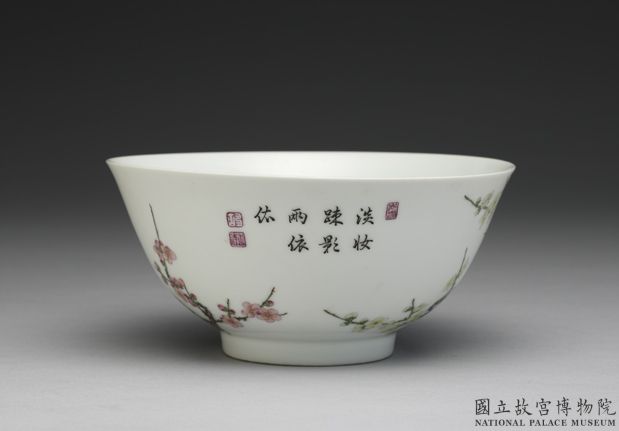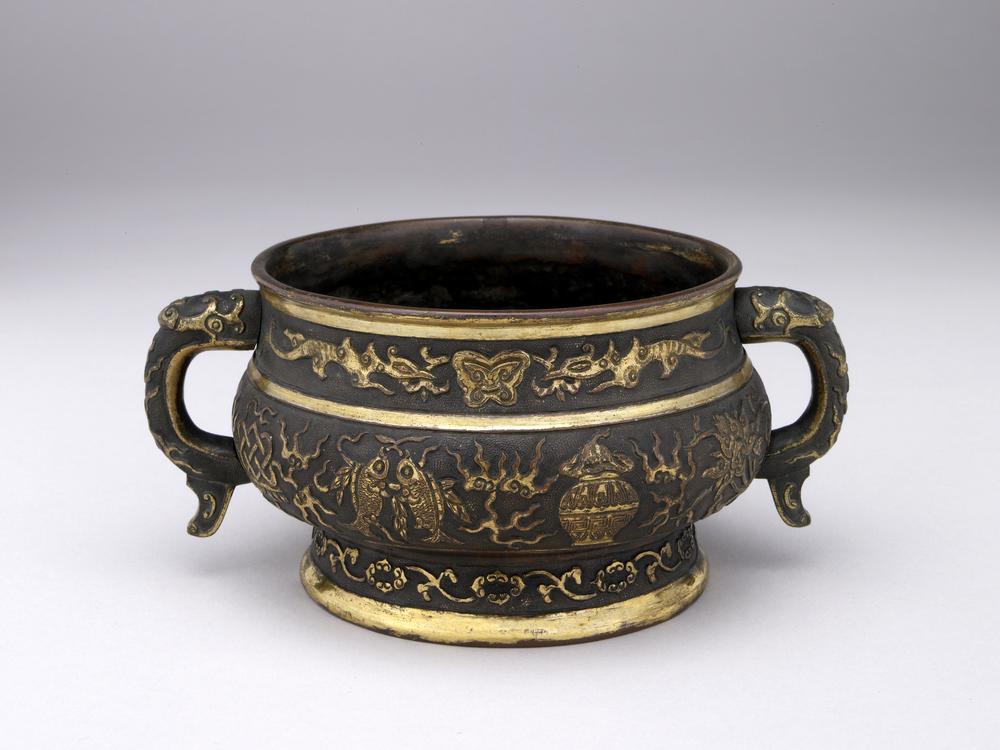Period:Western Zhou dynasty Production date:11thC BC-8thC BC
Materials:jade
Technique:drilled, incised,
Subjects:dragon
Dimensions:Length: 59 millimetres Length: 60 millimetres
Description:
Plaque/pendant of pale green semi-translucent jade. The plaque/pendant consists of two fragments. The upper fragment depicting a human face with large C-scroll ears, coiled nose, upturned mouth and muleiwen eyes below striated hair, surmounted by a recessed tab with two diagonally drilled holes; the remainder of the body in a seated position, the bent upper arm and lower bird-like leg terminating in elongated talons. The lower fragment with stylized dragon with head and long coiled snout and tusks below elongated eyes extending up and backwards into horns, the coiled body with scrolls, all delineated by double incised lines, with a recessed notched tab below.
IMG
![图片[1]-plaque; pendant BM-2022-3034.127-China Archive](https://chinaarchive.net/Western Zhou dynasty/Jades/mid_Jade_plaques_2.jpg)
![图片[2]-plaque; pendant BM-2022-3034.127-China Archive](https://chinaarchive.net/Western Zhou dynasty/Jades/mid_498_1_1_cropped.jpg)
Comments:Western Zhou. Length 60mm and 59mm. 498.1 is the righthand object above. See Stanford 1958, Ecke 1961, Salmony 1963, and Ayers and Rawson 1975. Possibly Western Zhou, 10th century BC. These two plaques are slightly puzzling, both in form and design. They appear to ghave been cut from a single straight plaque with a shaped top and a notched bottom, both of which makes thin tangs. In addition, the plaques have notches or indentations along their sides, and both have a large hook or volute cut out of them. On the upper plaque is a man’s head with a bent arm, finishing in a claw. Below is the foot of a bird and then various filler patterns to complete the surface. On the lower plaque the main figure is a dragon with a long snout, a conspicuous eye and a large rounded ear or horn. The surface is filled with fine engraves lines terminating in small rounded scrolls. The reverse side of both plaques is undecorated. In style, the lines on the present plaques match those of the first stages of the incised designs at the end of the early Western Zhou. They can, for example, be compared with the design on a magnificent handle in the Metropolitan Museum, New York. However, the detail of the ornament is rather unconventional. The first idiosyncrasy is the way in which a bird’s leg and talon is attached to the body of the manlike figure. Normally the heads of such men are grasped in the talons of the bird. Further, the dragon’s head is much more elongated than that of the dragons usually seen on such pieces as the Metropolitan handle. Because these two plaques are not entirely standard Western Zhou pieces, it is possible that they have been modified at some stage in their history. See Rawson 1995, p.242, cat.no.14.7.8.
Materials:jade
Technique:drilled, incised,
Subjects:dragon
Dimensions:Length: 59 millimetres Length: 60 millimetres
Description:
Plaque/pendant of pale green semi-translucent jade. The plaque/pendant consists of two fragments. The upper fragment depicting a human face with large C-scroll ears, coiled nose, upturned mouth and muleiwen eyes below striated hair, surmounted by a recessed tab with two diagonally drilled holes; the remainder of the body in a seated position, the bent upper arm and lower bird-like leg terminating in elongated talons. The lower fragment with stylized dragon with head and long coiled snout and tusks below elongated eyes extending up and backwards into horns, the coiled body with scrolls, all delineated by double incised lines, with a recessed notched tab below.
IMG
![图片[1]-plaque; pendant BM-2022-3034.127-China Archive](https://chinaarchive.net/Western Zhou dynasty/Jades/mid_Jade_plaques_2.jpg)
![图片[2]-plaque; pendant BM-2022-3034.127-China Archive](https://chinaarchive.net/Western Zhou dynasty/Jades/mid_498_1_1_cropped.jpg)
Comments:Western Zhou. Length 60mm and 59mm. 498.1 is the righthand object above. See Stanford 1958, Ecke 1961, Salmony 1963, and Ayers and Rawson 1975. Possibly Western Zhou, 10th century BC. These two plaques are slightly puzzling, both in form and design. They appear to ghave been cut from a single straight plaque with a shaped top and a notched bottom, both of which makes thin tangs. In addition, the plaques have notches or indentations along their sides, and both have a large hook or volute cut out of them. On the upper plaque is a man’s head with a bent arm, finishing in a claw. Below is the foot of a bird and then various filler patterns to complete the surface. On the lower plaque the main figure is a dragon with a long snout, a conspicuous eye and a large rounded ear or horn. The surface is filled with fine engraves lines terminating in small rounded scrolls. The reverse side of both plaques is undecorated. In style, the lines on the present plaques match those of the first stages of the incised designs at the end of the early Western Zhou. They can, for example, be compared with the design on a magnificent handle in the Metropolitan Museum, New York. However, the detail of the ornament is rather unconventional. The first idiosyncrasy is the way in which a bird’s leg and talon is attached to the body of the manlike figure. Normally the heads of such men are grasped in the talons of the bird. Further, the dragon’s head is much more elongated than that of the dragons usually seen on such pieces as the Metropolitan handle. Because these two plaques are not entirely standard Western Zhou pieces, it is possible that they have been modified at some stage in their history. See Rawson 1995, p.242, cat.no.14.7.8.
© Copyright
The copyright of the article belongs to the author, please keep the original link for reprinting.
THE END





